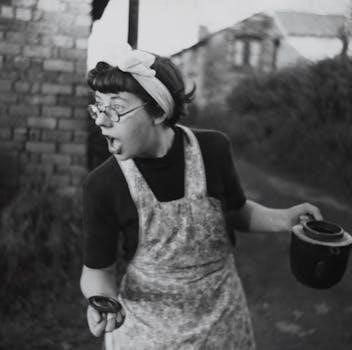Overview of ‘Story of O’
Story of O, originally published in French as Histoire d’O, is a controversial novel exploring female submission through the journey of O. Written under the pseudonym Pauline Réage, it is a dark romance that delves into BDSM themes, focusing on explicit sexual encounters and power dynamics. The text features a detailed look at the plot, characters, and the impact it has had on literature.
Author and Publication
The novel Story of O was initially published in 1954 in French under the pen name Pauline Réage; This pseudonym concealed the true identity of the author, Dominique Aury, a respected French writer and translator within the literary establishment. Aury used the pen name to publish the work due to its explicit content and controversial nature. It wasn’t until 1994 that her identity as the author was publicly confirmed, which brought renewed attention to the novel. The book was written to keep the interest of her lover Jean Paulhan, who taunted her that a woman couldn’t write a good erotic novel. Aury, under the pseudonym Réage, published the novel, which has since become a transgressive classic.
Pseudonym and Real Identity
The author of Story of O, known to the public for many years as Pauline Réage, was in reality Dominique Aury. Aury, a French intellectual, used the pseudonym to shield her identity due to the novel’s controversial and sexually explicit nature. The pen name, Pauline Réage, became synonymous with the book for decades, creating a sense of mystery around its origins. Aury, a respected figure in literary circles, chose to maintain her anonymity, which added to the intrigue surrounding the novel. Her true identity was not confirmed until 1994, revealing the author as a woman of significant intellectual background. This revelation further intensified the discussion and analysis of the book.

Plot and Narrative Structure
The narrative follows O’s journey into a world of submission. The story progresses through a series of increasingly intense experiences, revealing a complex structure centered on her transformation.
The novel opens in an unspecified time in Paris, where we meet the protagonist, known only as O. She is a beautiful Parisian fashion photographer. The story begins with O encountering her lover, René, in a park she has never visited before. René instructs her to enter a waiting taxi, marking the start of her journey into a world unknown to her. This initial setting is crucial, as it establishes the abrupt transition O experiences from a seemingly ordinary life into one of submission. The immediate command to enter the taxi and the comment about her clothing being “too much” immediately signals the shift in power dynamics and expectations that she will soon face. This introduction sets the stage for the exploration of themes of control and the loss of individuality.
O’s Journey into Submission
O’s journey is a descent into increasingly submissive behavior. She is taken to a château in Roissy where she undergoes training to serve an elite club. This training involves being stripped, whipped, and subjected to various sexual acts, all in the name of devotion to René. She is taught to be available for oral, vaginal, and anal intercourse, offering herself to any male within the secret society. This process gradually strips away her individual identity, leading her to abandon her independence of thought. O’s transformation is not just physical but also psychological, as she accepts and even embraces her role as a sexual object, showcasing the complex and controversial themes within the novel.
The Secret Society and Its Rules
The secret society in Story of O functions as the central mechanism for O’s submission. This elite club operates with a strict set of unwritten rules, where members, primarily men, hold absolute power over the women. The women are treated as sexual objects, trained to be constantly available for the men’s desires. The society’s rules dictate that women must be compliant and subservient, with no autonomy or personal agency. O is subjected to these rules and is expected to obey without question. The society’s clandestine nature and harsh practices create an environment of dominance and control, emphasizing the themes of power and submission that permeate the novel.

Themes and Interpretations
Story of O explores complex themes of power, submission, and sexuality through its explicit content and dark narrative. The novel delves into the BDSM realm, challenging traditional notions of love and control.
Exploration of BDSM Themes
Story of O is renowned for its explicit exploration of BDSM themes, delving into the intricacies of bondage, discipline, dominance, submission, sadism, and masochism. The narrative depicts O’s journey into complete submission, where she is trained to be sexually available to any man belonging to her lover’s secret society. The novel portrays graphic scenes of sexual encounters, violence, and humiliation, pushing the boundaries of what was acceptable in literature at the time of its publication. The portrayal of these acts is not merely for shock value; it’s integral to the themes of power dynamics and control that permeate the story. Through O’s experiences, the novel examines the complex relationship between pain, pleasure, and the relinquishing of personal autonomy. It challenges readers to confront their own perceptions of sexuality, consent, and the nature of desire, making it a significant text in discussions about BDSM and its representation in art.
Power Dynamics and Control
The narrative of Story of O is deeply embedded in the exploration of power dynamics and control, primarily through the relationships between O and the men who dominate her. O’s journey begins with her lover, René, who introduces her to a secret society where she relinquishes her autonomy. This transfer of control escalates as O is subjected to increasingly extreme acts of submission, highlighting the dynamics of dominance and submission within the BDSM context. The men wield power over her body, her choices, and even her identity, showcasing the complete subjugation that she undergoes. The novel examines how these power structures affect O’s sense of self, her desires, and her perceived freedom, exploring the paradoxical nature of her narrative, where she finds a sense of liberation through her submission. It also probes the psychological impacts of control, raising questions about consent, agency, and the complex interplay of power in relationships.

Literary Elements and Style
The novel employs symbolic imagery, particularly mirrors, to reflect O’s objectification and loss of self. The narrative voice primarily follows O’s perspective, creating an intimate and unsettling portrayal of her submission.
Symbolism and Motifs
Mirrors are a pervasive motif in Story of O, reflecting the protagonist’s objectification and the constant surveillance she experiences. They symbolize her loss of self and the way she is viewed and controlled by others. The use of mirrors highlights the theme of external perception versus internal identity. The act of being stripped and having clothes removed is symbolic of stripping away her personal identity. The novel also utilizes physical markings, such as branding, to represent ownership and the permanent nature of O’s submission. These motifs emphasize the themes of power, control, and the erasure of individual agency within the narrative. These are powerful tools used to convey the complex nature of O’s experience and the society she is trapped within.
Narrative Perspective and Voice
The narrative of Story of O employs a third-person perspective, primarily focusing on O’s experiences and internal thoughts, granting the reader access to her feelings and reactions. However, this perspective is not fully personal, as the narrator often maintains a detached and clinical tone, which adds to the unsettling nature of the story. The voice is often passive, reflecting O’s own acceptance of her circumstances. The narrative choices contribute to the novel’s exploration of power dynamics by highlighting the contrast between O’s subjective experience and the objective reality of her situation. The story’s voice serves to emphasize the disorienting and dehumanizing effects of the world she enters.

Reception and Impact
Story of O faced significant controversy and banning due to its explicit content. It has also been subject to substantial literary analysis, with critics debating its themes and artistic merit;
Controversy and Banning
The explicit nature of Story of O, particularly its detailed depictions of BDSM practices and female submission, led to widespread controversy upon its initial publication. Many found the novel’s content shocking and morally objectionable, leading to its banning in several countries. The book’s exploration of power dynamics and the objectification of women sparked intense debates about its artistic value versus its perceived exploitation. The graphic sexual scenes and the seemingly willing participation of the protagonist, O, challenged conventional notions of morality, resulting in strong reactions from both literary critics and the general public. The work’s transgressive themes made it a lightning rod for discussions surrounding censorship, freedom of expression, and the boundaries of acceptable literature. The novel’s provocative nature continues to fuel discussions about the ethics of its content.
Literary Analysis and Criticism
Literary analysis of Story of O often focuses on its complex themes of power, submission, and the construction of female identity. Critics have explored the novel’s use of symbolism, particularly the recurring motif of mirrors, and its exploration of the paradoxical nature of O’s journey. Some interpretations argue that the novel is a critique of traditional gender roles and societal expectations, while others view it as a problematic endorsement of female subjugation. The narrative perspective, primarily through O’s internal thoughts, invites readers to grapple with the ambiguities of her desires and motivations. Scholars also debate the novel’s literary merit, with some praising its stylistic innovation and others dismissing it as mere pornography. The work’s place in the canon of erotic literature remains a subject of ongoing discussion and debate.

Leave a Reply
You must be logged in to post a comment.